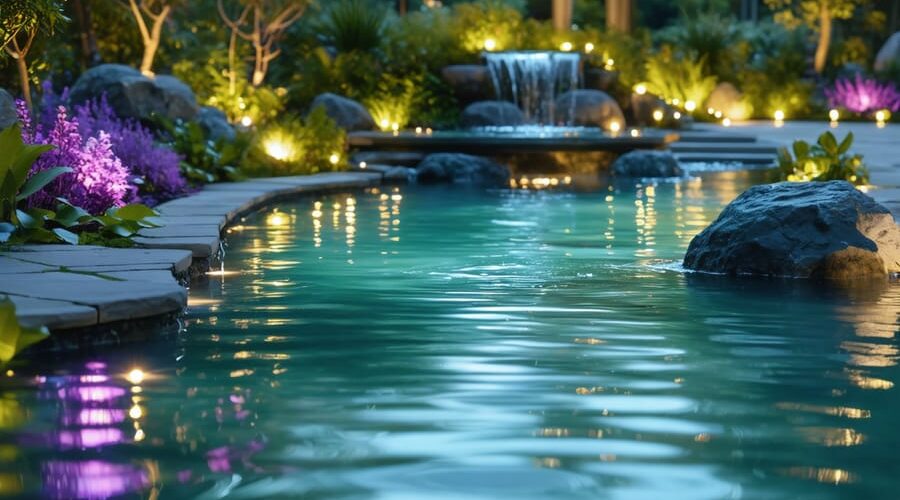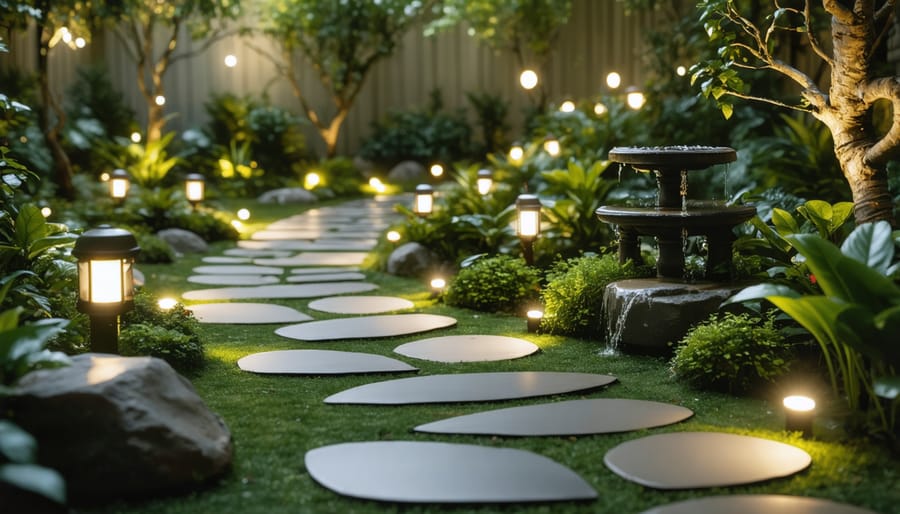
Transform Your Water Feature with Smart Outdoor Lighting (Simple Expert Tips)
Transform your outdoor space into a captivating nighttime sanctuary with strategically placed lighting that balances beauty and functionality. While following essential outdoor lighting design principles, modern outdoor illumination goes far beyond simple porch lights and spotlights. From energy-efficient LED path markers to sophisticated smart lighting systems, today’s outdoor lighting options offer unprecedented control over ambiance, security, and energy consumption.
Whether you’re looking to highlight architectural features, illuminate gathering spaces, or enhance landscape elements, understanding the distinct categories of outdoor lighting empowers you to create the perfect evening atmosphere. Solar-powered solutions provide sustainable brilliance, while low-voltage systems offer reliable performance with minimal energy costs. Advanced motion sensors and automated controls now make it possible to customize your lighting experience for different occasions, seasons, or times of day.
Let’s explore how various lighting types – from subtle wash lights to dramatic uplighting – can work together to create your ideal outdoor environment, while maintaining safety and energy efficiency throughout your landscape.
Submersible Lighting: Below-Water Magic
LED Pond Lights
LED pond lights have revolutionized water feature illumination, offering a perfect blend of practicality and beauty. The benefits of LED lighting are particularly evident in pond applications, where their energy efficiency and longevity make them an ideal choice for continuous underwater use.
These versatile lights can transform your pond into a mesmerizing nighttime display while consuming up to 80% less electricity than traditional lighting options. Their low heat output makes them safe for aquatic life, and their waterproof designs ensure reliable performance year after year.
Whether you’re highlighting water lilies, creating subtle underwater effects, or illuminating fountain streams, LED pond lights offer incredible flexibility. Available in various colors and intensities, they allow you to create different moods throughout your water garden. Some models even come with color-changing capabilities, letting you switch between peaceful white light for everyday use and vibrant colors for special occasions.
Installation is typically straightforward, with many LED pond lights featuring weighted bases or stake mounting options. Modern versions often include remote controls or smartphone connectivity, making it easy to adjust brightness levels and colors from the comfort of your home.
The long lifespan of LED lights – often 50,000 hours or more – means less maintenance and fewer bulb replacements, especially important for underwater fixtures where access can be challenging.

Color-Changing Options
Color-changing LED systems have revolutionized outdoor lighting, offering endless possibilities for creating different moods in your garden. With RGB (Red, Green, Blue) technology, you can transform your outdoor space from a calming blue sanctuary to a vibrant party venue at the touch of a button.
Modern RGB lighting systems come with user-friendly controllers that let you select from preset color schemes or create your own custom combinations. Many systems now include smartphone apps, allowing you to adjust colors, brightness, and timing schedules from your mobile device. You can even sync multiple lights to create coordinated light shows across your entire outdoor area.
These versatile lights are perfect for highlighting water features, where changing colors can enhance the natural movement of water. Imagine your fountain displaying a soft white glow during dinner parties, switching to a romantic purple for evening gatherings, or cycling through a rainbow of colors during special celebrations.
For the best results, consider installing color-changing lights in layers. Place some lights at ground level to illuminate pathways, others at mid-height for shrubs and garden features, and additional lights aimed upward to highlight trees or architectural elements. This layered approach creates depth and allows for more dramatic color-changing effects.
While these systems typically cost more than traditional outdoor lights, their versatility and long lifespan make them a worthwhile investment for anyone looking to create dynamic outdoor spaces.
Surrounding Area Illumination
Path and Border Lights
Path and border lights serve as both practical safety features and attractive design elements in your outdoor space. These versatile fixtures illuminate walkways, define garden boundaries, and create an inviting atmosphere throughout your landscape. When properly placed, they prevent trips and falls while guiding visitors safely through your garden – making them essential for following proper landscape lighting safety tips.
For walkways, space lights about 6-8 feet apart on alternating sides to create an even wash of light without harsh spotlighting. Low-voltage LED path lights are ideal, as they’re energy-efficient and cast a warm, welcoming glow that won’t overwhelm the space. Consider fixtures with downward-facing shields to minimize light pollution and glare.
Border lights work beautifully to highlight garden edges, flower beds, and the perimeter of water features. Choose styles that complement your garden’s theme – from classic copper fixtures to modern minimalist designs. Solar-powered options are particularly convenient for areas far from electrical outlets, though they may provide less consistent lighting than wired alternatives.
For the best results, layer your lighting by combining path lights with other fixture types. Use taller bollard lights at entry points and transitions, then transition to shorter mushroom-style or stake lights along pathways. This creates depth and interest while maintaining safety and functionality. Remember to position lights away from areas where they might be damaged by lawn equipment or foot traffic.
Many modern path and border lights now include smart features like motion sensors, automatic timers, and smartphone controls, making it easier than ever to manage your outdoor lighting efficiently.

Spotlights and Uplighting
Spotlights and uplighting are game-changers when it comes to creating drama and depth in your outdoor space. These lighting techniques can transform your garden from flat and lifeless after dark to a stunning three-dimensional nighttime display.
Spotlights are versatile workhorses in outdoor lighting. Position them at ground level or mount them on trees to create focused beams of light that highlight specific features. They work beautifully for illuminating tall trees, drawing attention to unique architectural elements, or showcasing statement plants in your garden. For the best results, aim spotlights at a 45-degree angle to minimize harsh shadows and create natural-looking illumination.
Uplighting takes a different approach by placing fixtures at ground level and directing light upward. This technique creates striking visual effects, especially when used to illuminate trees, columns, or textured walls. The upward beam adds depth and creates interesting shadows that dance across surfaces. For water features, uplighting can create magical effects as light plays off moving water and reflects onto surrounding surfaces.
When installing either type of lighting, remember these key tips:
– Use warm white lights (2700-3000K) for a natural, welcoming feel
– Position lights far enough from features to avoid hot spots
– Layer multiple lights for more natural-looking effects
– Consider using LED fixtures for energy efficiency
– Install fixtures slightly back from pathways to prevent tripping hazards
For maximum impact, combine both spotlighting and uplighting techniques. For example, use uplighting on your house’s façade while adding spotlights to illuminate key landscape features. This layered approach creates depth and interest while ensuring your outdoor space remains functional and beautiful after dark.

Solar vs. Low-Voltage Systems
Solar-Powered Solutions
Solar-powered lights have become increasingly popular for outdoor lighting, offering an eco-friendly and cost-effective solution for illuminating your garden spaces. These lights harness the sun’s energy during the day through small solar panels, storing it in rechargeable batteries to power LED bulbs at night.
One of the biggest advantages of solar lighting is the complete elimination of electrical wiring, making installation a breeze for DIY enthusiasts. Simply stake them into the ground where they receive adequate sunlight, and they’ll automatically turn on at dusk. Plus, you’ll never see an increase in your electricity bill, no matter how many solar lights you add to your landscape.
However, it’s important to understand their limitations. Solar lights typically aren’t as bright as their hardwired counterparts, and their performance depends heavily on weather conditions and sunlight exposure. During cloudy days or winter months, you might notice reduced lighting duration or brightness. To get the best performance, place solar lights in areas that receive 6-8 hours of direct sunlight daily.
Modern solar lights come in various styles, from pathway markers to spotlight fixtures, and many now include motion sensors and adjustable brightness settings. For the best results, consider using solar lights for accent lighting or path illumination rather than primary security lighting. Clean the solar panels periodically with a soft cloth to maintain optimal charging efficiency.
Low-Voltage Lighting Systems
Low-voltage lighting systems are a popular choice for outdoor lighting, offering a perfect balance of safety, efficiency, and versatility. These systems typically operate at 12 volts instead of standard 120-volt household current, making them much safer to install and maintain, especially around water features.
The basic setup includes a transformer that converts standard household voltage to low voltage, a cable that connects the lights, and the lighting fixtures themselves. You can easily install these systems yourself, as they don’t require deep burial of cables or complex electrical knowledge. Simply lay the cable on the ground and cover it with mulch or shallow soil.
One of the biggest advantages of low-voltage systems is their energy efficiency. They consume less power than traditional lighting while still providing ample illumination for pathways, garden features, and architectural elements. The fixtures come in various styles, from spotlights and path lights to underwater options perfect for ponds and fountains.
Modern low-voltage systems often include smart features like programmable timers, motion sensors, and even smartphone control capabilities. This allows you to create sophisticated lighting schedules and adjust brightness levels to suit different occasions or seasons.
While the initial cost might be higher than basic solar options, the long-term benefits of durability, reliability, and superior light quality make low-voltage systems an excellent investment for any outdoor space.
Smart Integration and Control
Today’s outdoor lighting solutions offer unprecedented control and convenience through modern technology. With smart garden automation systems, you can transform your outdoor space into an intelligent environment that responds to your needs and schedule.
Many smart lighting systems now work with popular voice assistants like Alexa or Google Home, letting you control your outdoor lights with simple voice commands. You can say “turn on the pond lights” or “dim the garden path” without reaching for a switch. Smartphone apps provide even more control, allowing you to adjust brightness levels, create custom lighting scenes, and set automated schedules from anywhere.
Motion sensors add both convenience and security to your outdoor lighting setup. Lights can automatically illuminate when someone walks down your garden path or approaches your water feature, then dim or turn off after a set time to save energy. Some systems even learn your daily patterns and adjust automatically.
Color-changing LED technology adds another layer of customization. You can program your lights to shift colors throughout the evening, create themed displays for holidays, or match your lighting to different occasions. Imagine your pond lights gradually transitioning from warm white to soft blue as twilight approaches.
Weather-responsive automation is particularly useful for outdoor lighting. Smart systems can turn lights on earlier on cloudy days or adjust brightness based on ambient light levels. Some can even integrate with weather forecasts to modify lighting schedules during storms or heavy rain.
Energy management features help you maintain an efficient lighting system. Monitor power usage through your app, set automatic timers to prevent lights from staying on unnecessarily, and receive alerts when bulbs need replacement. Many systems also offer vacation modes to simulate occupancy while you’re away, enhancing security without wasting energy.
Choosing the right outdoor lighting can transform your outdoor space from ordinary to extraordinary, creating an enchanting atmosphere that extends your living area well into the evening hours. Throughout this guide, we’ve explored various lighting options, from practical security lights to decorative landscape fixtures, each serving its unique purpose in outdoor illumination.
Remember that successful outdoor lighting combines different types of lights to achieve multiple goals. Layer your lighting by incorporating uplighting for trees and architectural features, path lights for safety and navigation, and accent lights to highlight special features like water fountains or garden sculptures.
For the best results, start with a lighting plan that considers your specific needs and space. Focus on energy-efficient LED options that will save money while providing reliable illumination. Don’t forget to include smart lighting controls, which offer convenience and flexibility in managing your outdoor lighting setup.
When installing outdoor lighting, always prioritize safety by using weather-resistant fixtures and following proper installation guidelines. Consider professional installation for complex systems, particularly when dealing with electrical connections.
Whether you’re creating a cozy patio setting, illuminating a walking path, or enhancing your home’s security, the right combination of outdoor lighting will help you achieve your goals while adding value and beauty to your property. Start with a small project and gradually expand your lighting scheme as you become more comfortable with the various options available.
